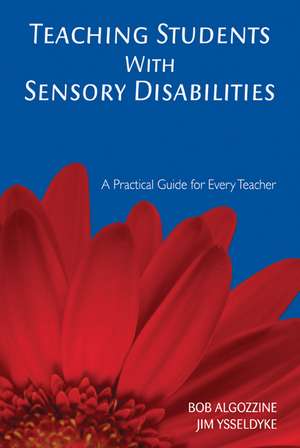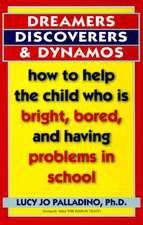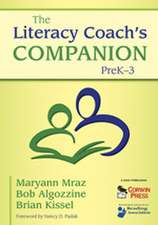Teaching Students With Sensory Disabilities: A Practical Guide for Every Teacher
Autor Bob Algozzine, James E. Ysseldykeen Limba Engleză Paperback – 7 iun 2006
Including a pre-test, post-test, and key vocabulary terms, this highly informative guide discusses everything educators need to know about students with sensory disabilities, including:
o Cognitive characteristics and issues
o Academic characteristics and issues
o Physical characteristics and issues
o Behavioural characteristics and issues
o Communication characteristics and issues
| Toate formatele și edițiile | Preț | Express |
|---|---|---|
| Paperback (1) | 181.97 lei 6-8 săpt. | |
| SAGE Publications – 7 iun 2006 | 181.97 lei 6-8 săpt. | |
| Hardback (1) | 443.97 lei 6-8 săpt. | |
| SAGE Publications – 22 mai 2006 | 443.97 lei 6-8 săpt. |
Preț: 181.97 lei
Nou
Puncte Express: 273
Preț estimativ în valută:
34.82€ • 36.22$ • 28.75£
34.82€ • 36.22$ • 28.75£
Carte tipărită la comandă
Livrare economică 14-28 aprilie
Preluare comenzi: 021 569.72.76
Specificații
ISBN-13: 9781412939003
ISBN-10: 1412939003
Pagini: 136
Dimensiuni: 152 x 229 x 9 mm
Greutate: 0.23 kg
Ediția:1
Editura: SAGE Publications
Colecția Corwin
Locul publicării:Thousand Oaks, United States
ISBN-10: 1412939003
Pagini: 136
Dimensiuni: 152 x 229 x 9 mm
Greutate: 0.23 kg
Ediția:1
Editura: SAGE Publications
Colecția Corwin
Locul publicării:Thousand Oaks, United States
Cuprins
About A Practical Approach to Special Education for Students With Special Needs
Acknowledgements
About the Authors
Self-Assessment I
Introduction to Teaching Students with Sensory Disabilities
1.What Should Every Teacher Know About Visual Impairments?
Definition
Eligibility for Special Education
Prevalence
What you May See in Your Classroom
2.What Should Every Teacher Know About Hearing Impairments?
Definition
Types of Hearing Loss
Prevalence
What you May See in Your Classroom
3.What Should Every Teacher Know About Deafness and Blindness?
Definition
Prevalence
Characteristics
4.What Tools and Strategies Should Teachers Use to Support Students With Sensory Disabilities?
Eliminate Barriers
Improve Communication
Foster Independence
5.Sensory Disabilities in Perspective
Understand Characteristics
Support Accomodations
Foster Collaboration
Prepare for the Future
6. What Have We Learned?
Key Points
More About Visual Impairments
More About Hearing Impairments
Key Vocabulary
Self-Assessment II
Answer Key for Self-Assessments
On Your Own
Resources
Websites
Books
Journals & Articles
Organizations
References
Index
Acknowledgements
About the Authors
Self-Assessment I
Introduction to Teaching Students with Sensory Disabilities
1.What Should Every Teacher Know About Visual Impairments?
Definition
Eligibility for Special Education
Prevalence
What you May See in Your Classroom
2.What Should Every Teacher Know About Hearing Impairments?
Definition
Types of Hearing Loss
Prevalence
What you May See in Your Classroom
3.What Should Every Teacher Know About Deafness and Blindness?
Definition
Prevalence
Characteristics
4.What Tools and Strategies Should Teachers Use to Support Students With Sensory Disabilities?
Eliminate Barriers
Improve Communication
Foster Independence
5.Sensory Disabilities in Perspective
Understand Characteristics
Support Accomodations
Foster Collaboration
Prepare for the Future
6. What Have We Learned?
Key Points
More About Visual Impairments
More About Hearing Impairments
Key Vocabulary
Self-Assessment II
Answer Key for Self-Assessments
On Your Own
Resources
Websites
Books
Journals & Articles
Organizations
References
Index
Notă biografică
Bob Algozzine is a professor in the Department of Educational Leadership at the University of North Carolina and project codirector of the U.S. Department of Education-supported Behavior and Reading Improvement Center. With 25 years of research experience and extensive firsthand knowledge of teaching students classified as seriously emotionally disturbed, Algozzine is a uniquely qualified staff developer, conference speaker, and teacher of behavior management and effective teaching courses. He is active in special education practice as a partner and collaborator with professionals in the Charlotte-Mecklenburg schools in North Carolina and as an editor of several journals focused on special education. Algozzine has written more than 250 manuscripts on special education topics, including many books and textbooks on how to manage emotional and social behavior problems.
Descriere
This valuable resource offers teachers practical classroom management tips and provides highly effective instruction methods to foster independence in students with visual and hearing impairments.











